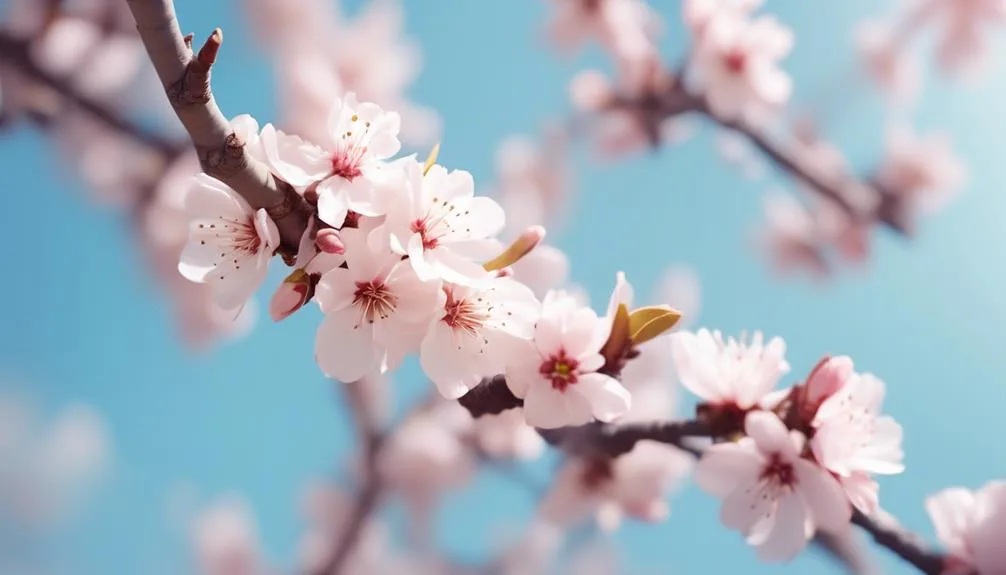Almond trees with their pretty pink blossoms are a lovely sight in spring.
But have you ever wondered why their flowers are pink?
The reason is a mix of genetics, the environment, and even historical and cultural significance.
Exploring the science behind the pink hue of almond blossoms reveals a world of natural wonder and discovery.
Join us as we uncover the captivating allure of these iconic trees.
Key Takeaways
- Almond tree blossom color is determined by genetic inheritance and the specific combination of genes that influence pigment production.
- Environmental factors such as climate, soil composition, temperature, humidity, precipitation, sunlight, and wind patterns also play a crucial role in determining the hues of almond blossoms.
- Pink blossoms have symbolic significance, representing hope, renewal, and the beginning of the fruit-bearing journey for almond trees. They also attract pollinators necessary for successful fertilization.
- Almond blossoms have rich cultural and historical associations, symbolizing beauty, purity, resilience, and featuring prominently in various forms of artwork throughout history.
Almond Tree Blossom Color Genetics
Understanding the genetics behind the color of almond tree blossoms can provide insight into the beautiful variations seen in nature. Genetic inheritance plays a crucial role in determining flower pigmentation. The specific combination of genes inherited from the parent trees influences the production of pigments, resulting in the diverse colors observed in almond tree blossoms.
For instance, the presence of certain genes may lead to the production of pigments that give rise to pink blossoms, while other combinations may result in white or pale pink flowers. This genetic diversity contributes to the stunning array of colors seen in almond tree blossoms, adding to the allure of these trees in orchards and natural landscapes.
The intricate interplay of genetic factors ultimately determines the exquisite hues that adorn almond tree blossoms each spring.
Environmental Factors Influencing Almond Blossom Color
The genetic diversity influencing the color of almond tree blossoms is further complemented by a range of environmental factors that play a significant role in determining the hues that adorn these exquisite flowers each spring. Climate effects and soil composition both contribute to the stunning array of colors seen in almond blossoms. The table below illustrates the impact of these environmental factors on almond blossom color.
| Climate Effects | Soil Composition |
|---|---|
| Temperature | pH levels |
| Humidity | Nutrient content |
| Precipitation | Drainage |
| Sunlight | Texture |
| Wind patterns | Organic matter |
Climate effects such as temperature, humidity, precipitation, sunlight, and wind patterns can influence the intensity and vibrancy of almond blossom colors. Similarly, soil composition, including pH levels, nutrient content, drainage, texture, and organic matter, also plays a crucial role in determining the hues of these delicate flowers.
Significance of Pink Blossoms for Almond Trees
Pink blossoms on almond trees captivate the senses with their delicate beauty and hold a vital significance in the lifecycle of the almond tree. They aren't merely a feast for the eyes, but also carry deep symbolism and horticultural significance.
Here's why the pink blossoms of almond trees are so important:
- Symbolism: The pink blossoms symbolize hope, renewal, and transformation. They mark the beginning of the almond tree's fruit-bearing journey, signifying potential and promise.
- They represent the fleeting beauty of life and the importance of seizing the moment, as the blossoms only last for a short period before giving way to new growth.
- Horticultural Significance: The color of the blossoms attracts specific pollinators crucial for the successful fertilization of almond flowers, ultimately leading to the production of almonds.
The pink blossoms, therefore, play a pivotal role not only in the almond tree's lifecycle but also in the broader natural ecosystem.
Cultural and Historical Associations With Almond Blossoms
With their rich cultural and historical associations, almond blossoms have long been revered for their symbolism and role in various traditions, extending beyond their horticultural significance. In many cultures, the almond blossom is a symbol of hope, renewal, and new beginnings. The delicate and fragrant blossoms have been featured in historical artwork, often representing beauty, purity, and resilience. Below is a table that summarizes the cultural symbolism and historical significance of almond blossoms:
| Cultural Symbolism | Historical Artwork |
|---|---|
| Hope and renewal | Depicted in ancient |
| and Renaissance art | |
| Beauty and purity | Featured in religious |
| paintings and tapestries | |
| Resilience | Symbol of strength in |
| various historical artworks |
Almond blossoms continue to be celebrated for their enduring significance in various cultural practices and artistic depictions.
Future Research on Almond Blossom Coloration
One potential avenue for future research on almond blossom coloration involves exploring the impact of environmental factors on the vibrant hues displayed by the blossoms. This research could delve into how varying levels of sunlight, temperature, and soil composition influence the pigmentation of almond blossoms.
Additionally, investigating the genetic variation within almond tree populations may provide valuable insights into the inheritance patterns of floral pigmentation. Understanding the specific genes responsible for producing pink hues in almond blossoms could open up new possibilities for selective breeding and genetic modification to enhance or alter blossom coloration.
Furthermore, exploring the biochemical pathways involved in floral pigmentation could shed light on the underlying mechanisms that govern the expression of color in almond blossoms. Such research could ultimately contribute to a deeper comprehension of the factors influencing almond blossom coloration.
Conclusion
Intriguing in both their genetic and environmental origins, the pink blossoms of almond trees serve as vital components in the pollination process and the eventual yield of almonds.
Their significance transcends their visual appeal, carrying cultural and historical connotations that enrich their beauty.
As we look to the future, the prospects for further exploration into almond blossom coloration hold promise.

